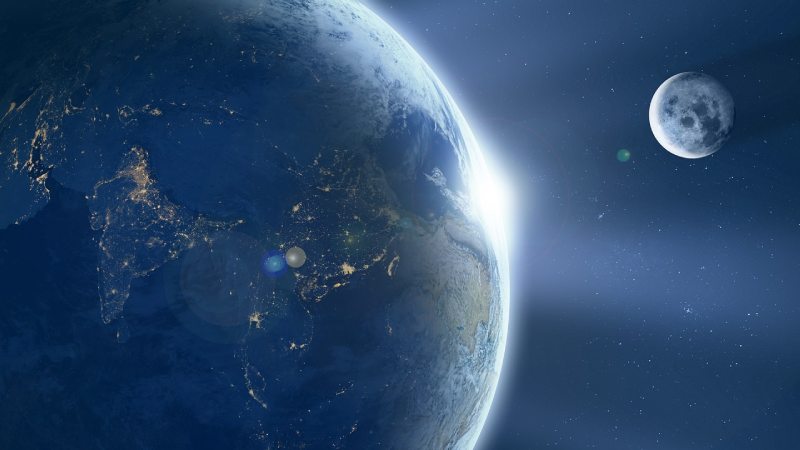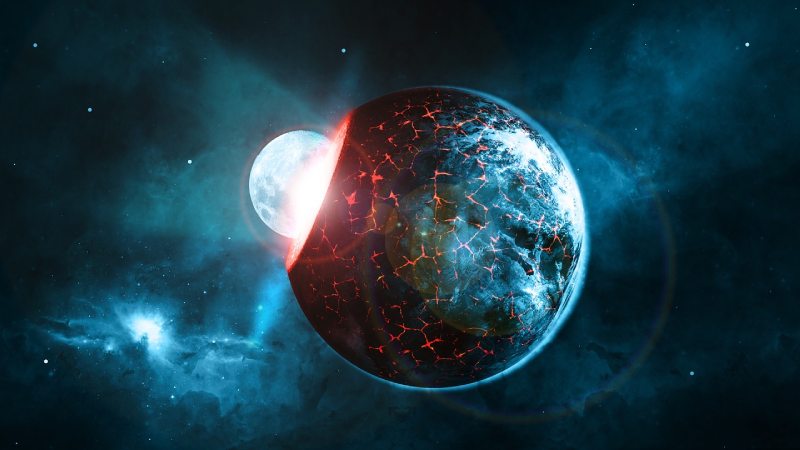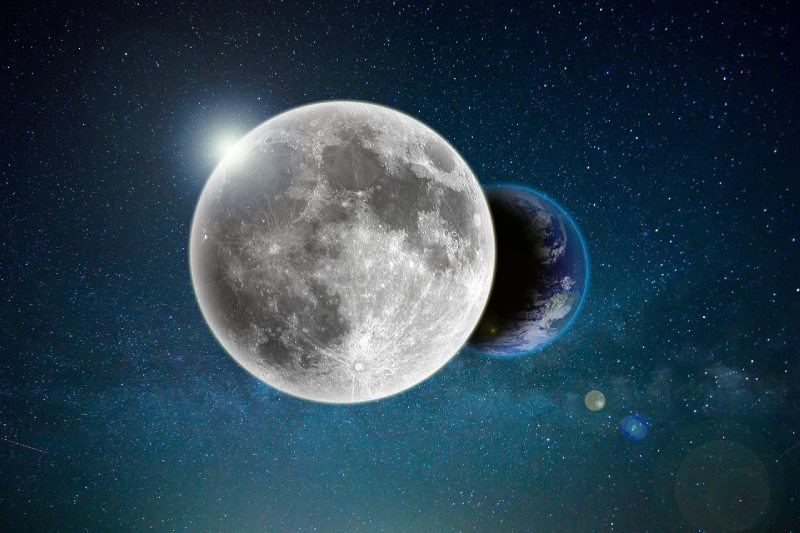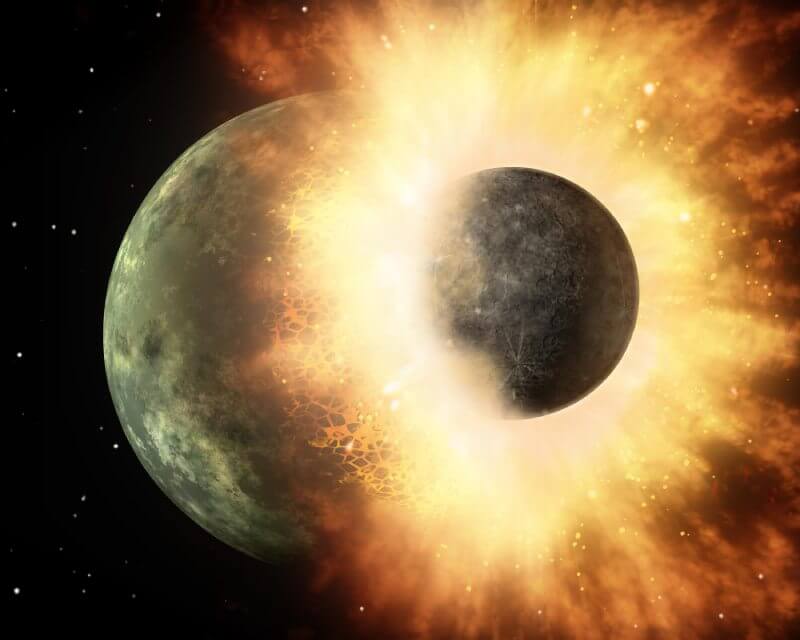The Moon is Earth’s only natural satellite and its beauty has captivated humans for all our time. It’s the fifth-largest Moon in our solar system and the closest celestial body to Earth. Despite the Moon being so close to Earth, scientists have only recently begun understanding how the Moon formed.
Studying the Moon is an ongoing process. Scientists are continually learning more about it and conducting research. NASA plans to return people to the lunar surface, one of the reasons why being to collect and study more samples. In the meantime, we’ll continue to ask, how was the Moon formed? This article will take a look at the theories and evidence behind them.
Moon Formation Theories
With hours of research, scientists and astronomers have proposed many theories explaining how the Moon originated. With time some have proven as unlikely, but there are still four theories considered to be the most likely. Most theories fail due to differences between the Moon and Earth. In some cases, simulations have proven theories unable to result in a moon of the correct size or orbital path.

What we do know about the Moon’s formation can be largely credited to the lunar rocks and samples returned with the Apollo missions. During the Moon’s history, its surface was at one point covered in an ocean of magma. We also know that the composition of rocks on Earth and the rocks from the Moon are very similar, except for the lack of iron on the Moon. The returned lunar samples also indicated the Moon formed around 60 million years ago.
Moon Capture Theory
In 1909, Thomas Jefferson Jackson See proposed the capture theory. This theory suggests, as it sounds that the Earth captured its Moon. In this theory, the Moon originated somewhere else in our solar system or possibly in the galaxy. As the Moon was traveling through the solar system, the gravitational forces of the Earth pulled the Moon in and captured it in its orbit.
Moon Fission Theory
There are a few variations of Fission Theory as scientists have continued to hypothesize. They all share the same foundational idea. The Fission Theory suggests that the Moon was once a part of the Earth. The theory is based on the idea that in Earth’s early stages, it rotated at a much faster pace than it does today. The idea was proposed by George Howard Darwin in 1878. The theory states that in the Earth spinning so quickly, a large piece tore off due to centrifugal force.
Moon Co-Formation Theory
In the co-formation theory, the Moon formed at the same time as Earth. The cloud of dust, gas, and particles that formed the Earth separated into two. One of these clouds turned into Earth’s smaller Moon. Also known as the co-accretion theory, the theory was developed in 2001 by Ryuji Morishima and Sei-ichiro Watanabe.
Giant Impact Theory
The leading theory on moon formation is the Giant Impact theory. First proposed by William Hartman and Donald Davis in 1974, the Giant Impact theory has scientific evidence supporting it. In this theory, another planet collided with Earth. The impact launched its outer layer into space, eventually creating the Moon. It’s this theory scientists believe can explain how the Moon formed.
The Leading Theory: Giant Impact Theory:
The most widely accepted theory of the Moon’s origin is the Giant Impact theory. In this theory, a planet roughly the size of Mars called Theia collided with Earth in its early history. The collision caused debris to fly off into space. With the help of gravitational force, the debris eventually formed into the Moon.

The Giant Impact theory is supported by evidence such as the similar composition to Earth. Computer simulations of the Giant Impact theory show that the event could have resulted in a moon with the correct orbit and makeup of our own.
The Giant Impact Theory Hypothesis
Also known as the Theia Impact or the Big Splash, the Giant Impact hypothesis suggests that the impact between the Earth and Theia occurred roughly 4.5 billion years ago. It’s thought the impact was so violent it caused Theia’s core and Earth’s mantle to turn into vapor. The vaporized materials formed a cloud of rock and metal that was very hot and dense. Over time, the cloud coalesced into the Moon.
The Giant Impact hypothesis explains characteristics of the Moon that other theories typically do not. One factor not explained by other suggested theories is the Moon’s much lower iron content than the Earth. With the Giant Impact theory, the vaporized material which formed the Moon may have lacked iron. It could also explain why the Moon has a much smaller iron core than the Earth.
Evidence of the Giant Impact Theory
The Giant Impact theory has become the leading theory because it answers most questions that follow when asking how the Moon formed.
The strongest evidence supporting the Giant Impact theory is from the lunar rocks and samples. The composition of these rocks has a very similar composition to Earth’s mantle. However, the Moon has lower iron and higher traces of certain isotopes.

Isotopes are when atoms of the same element have different amounts of neutrons within their nuclei. Isotopes present in the samples from the Moon are very different from the Earth’s rocks. This aspect leads scientists to believe the Moon did not form solely out of material from the Earth.
The chemical makeup of the Moon’s rocks could also be explained by the Giant Impact theory. Elements such as potassium, sodium, and zinc are found in much lower concentrations in moon rocks compared to the Earth’s rocks. Scientists believe it’s due to the high temperatures generated by the Giant Impact. It’s possible the extreme temperatures may have caused these elements to evaporate.
Conclusion: Mysteries of the Moon’s Formation
While the Giant Impact theory is the most widely accepted and plausible, there are still questions that go unanswered. Scientists are still trying to determine the reasons behind the differences between the Earth’s and the Moon’s composition. There are still a lot of things we have yet to discover about the early solar system and processes which formed planets and their moons.
Studying the Moon’s formation provided us with valuable insights, not only about the Moon but about the history of our solar system. Thanks to studying the lunar rocks and other samples of the Moon’s geology, scientists have been able to develop a timeline of not only the Earth’s formation but other planets in our solar system as well.
Just as it has for centuries, the Moon continues to be a source of fascination and a subject of study. Asking how the Moon formed will continue to be a question asked until the discoveries proving its origins are one day made.

